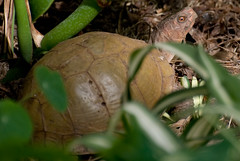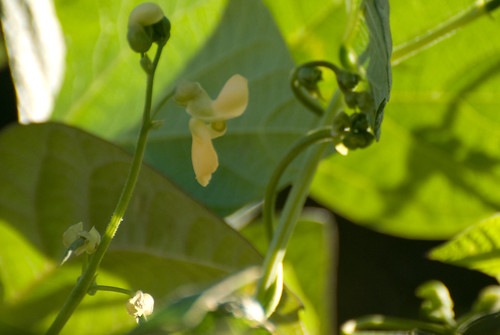Additionally, when I moved in -- and periodically thereafter -- I mulched the whole area with at least 6 inches of commercial Redwood Compost. Over time, the mulch breaks down, is transported underground by various organisms (including earthworms), and just seems to melt into the ground. This actually feeds the soil (and the organisms that live in the soil) over time.
As it turns out, when I planted the seeds and transplanted the seedlings, I pretty much had to jump back because everything came charging out of the ground like gangbusters. Happy! Happy! Joy! Joy!
However, this is not necessarily a good thing. It means that everything has plenty of nitrogen. Nitrogen is needed for strong stem and foliage growth. It's the N of the NPK ratio that's printed on every box or bag of fertilizer (organic or inorganic).
Plenty of nitrogen is good, but it's not enough. What about making actual fruits, like tomatoes, zucchini, squash, and beans? What about making the flowers that lead to the actual fruits? And what about the roots of the carrots and beets?
Well, that's where phosphorus comes in. P (the second number on the box or bag of fertilizer) is responsible for healthy root growth and flower and seed production. No P, no flowers, no fruits, no seeds. Bummer!
I knew I had a problem (not enough or unavailable phosphorus) because the tomatoes were rampantly growing into wildly gigantic green vine-y shrubs and hardly putting on any blossoms. I knew I had a problem because the bean vines had reached over the top of the 7-foot fence and had put on no blossoms. I knew I had a problem because the very few zucchini and summer squash fruits could sit on the vines for a few days without growing into serial killers.
OK. So, I need to add a source of phosphorus. As you might have guessed, I prefer to garden "organically." I prefer to use compost and even make my own. When I resort to commercial additives, I prefer to go with an "organic" alternative. For example, if I needed to boost the nitrogen levels in the soil, I could use blood meal (yes, made from blood), fish meal, or fish emulsion fertilizer. (The bonus for this last one is that, while the numbers are low -- 5-1-1 -- you can actually mix it with water and spray it right on the plant for instant absorption and jump-back growth. But I digress.)
The "organic" alternatives for phosphorus are bone meal, bat guano, and rock phosphate. But this is a problem. All of these alternatives are very high in calcium and miscellaneous salts. The reason this is a problem is that the soil in this area is already quite high in calcium and other salts quite naturally because this used to be a seabed before the Pacific plate jacked us up. And this is exacerbated by irrigation because our water is so hard (very high in dissolved calcium salts). And, besides, these "organic" solutions take months to work.
Did I mention that this is a complex subject? Well, here's another complexity. It's quite possible that there is plenty of phosphorus in the soil, but it's just not available to the plants because the soil pH in the dry regions of the west (and this is one) is naturally well above 7.0. Why? Because our hot, dry weather concentrates the naturally-occurring salts in the top soil through evaporation and the salts cause a too-high pH. Phosphorus needs a pH of 6.0 - 6.8 to be "available" to the plants.
So, gotta repair the pH. "Organically." The "organic" solution is to mulch the area with pine needles or redwood compost. (Oh, wait. We've been doing that.) The other "organic" solution is to add ground sulfur to the soil. I added it, but it takes time (months) for that to work.
So, I went nuts. I went officially non-organic. I added a wee touch of a product called SuperPhosphate. It's a form of phosphate that doesn't suffer from extra calcium, just a bit of extra sulfur. Oh, baby! A week later...
Rich yellow bean flower and two embryonic green beans in the lower left corner. The rest of the vines are showing similar progress. There are yellow, cream, and purple bean flowers all over the top third of the vines along with a bunch of baby bean pods.
At the same time as I gave a touch of SuperPhosphate and sulfur to the beans, I gave the same mix to all of the veggies except the beets. They all are responding either with more blossoms, more fruits, faster fruit growth (indicating faster seed growth), or faster fruit ripening.
What a difference a week makes!
Am I worried? Non-organic fertilizers are supposed to be death to the soil and the organisms therein. But, given that I have spent years feeding the soil with compost, I don't think one light application of SuperPhosphate is going to undo all the work that all that organic matter has done. For one thing, compost is The Great Soil Corrector. (Huh?) Soil too basic? Compost will acidify it. Soil too acid? Compost will buffer it. Soil too sandy so your water drains away too fast? Compost will hold the water. Clay soil? Compost will make air gaps so water drains and your roots can breathe. Compost invites earthworms to dine and the worms make tunnels for the roots to grow through and their castings (worm poop) is a highly-concentrated, readily-available fertilizer. Compost has carbon and nitrogen, the building blocks your plants need to grow -- and they are slowly released into the soil at a rate your plants can use.
I will continue to top-dress with compost to give the soil all of those benefits and help mitigate any damage I might have done with the SuperPhosphate.
And that's just about correcting an apparent phosphorus deficiency. I told you it was a complex subject.











Cool to know how well the supplement worked. Everything I've learned about compost leads me to say that compost in itself isn't really a fertilizer--it's a great organic soil amendment, which helps retain nutrients (if it's not too raw & therefore sucking up nitrogen), but by itself doesn't necessarily have a lot of the required ingredients. Kinda depends on what you put into it and how long it has been aging. Worm castings (if not too heavily processed by worms) are supposed to concentrate nutrients more, hence it being marketed as fertilizer.
ReplyDeleteAnother reason for salinity of our soil is that we (at least a good portion of the valley) get water from the Sac'to delta area, which esp. during the summer when we're sucking it dry can be quite saline.
Yeah, compost isn't *really* a fertilizer, especially given that you can't really say what the NPK ratio is (even tho most bags of commercial compost have an [exceedingly low] NPK ratio printed on the bag) and given that the NPK of it is so very low. But the NPK of fish emulsion is also really low. Then there's the point that, depending on what went into the compost pile/bin, you may or may not get any of the other micronutrients required for healthy plant growth.
ReplyDeleteThe thing that is troubling me about my veggie plot is that, given the amount of compost and other organic material I've added over the years, the pH shouldn't be so far out of whack as to tie up phosphate. And the pH isn't so far out of whack that it's tying up iron (no sign of chlorosis). So, can it be that the soil is that deficient in phosphorus? That seems wrong, too, given that there's a huge rosebush a couple of feet away that has been covered with blossoms in waves all spring and summer.
I knew our water in SJ was "surface water," but I didn't realize we were sucking delta water. Eeew! And as to the salinity of SJ water... When the water store I was frequenting went under, I got a Britta pitcher. The water from the pitcher tastes like salt was added. Not a *pile* of salt, but definitely a slightly brackish taste.